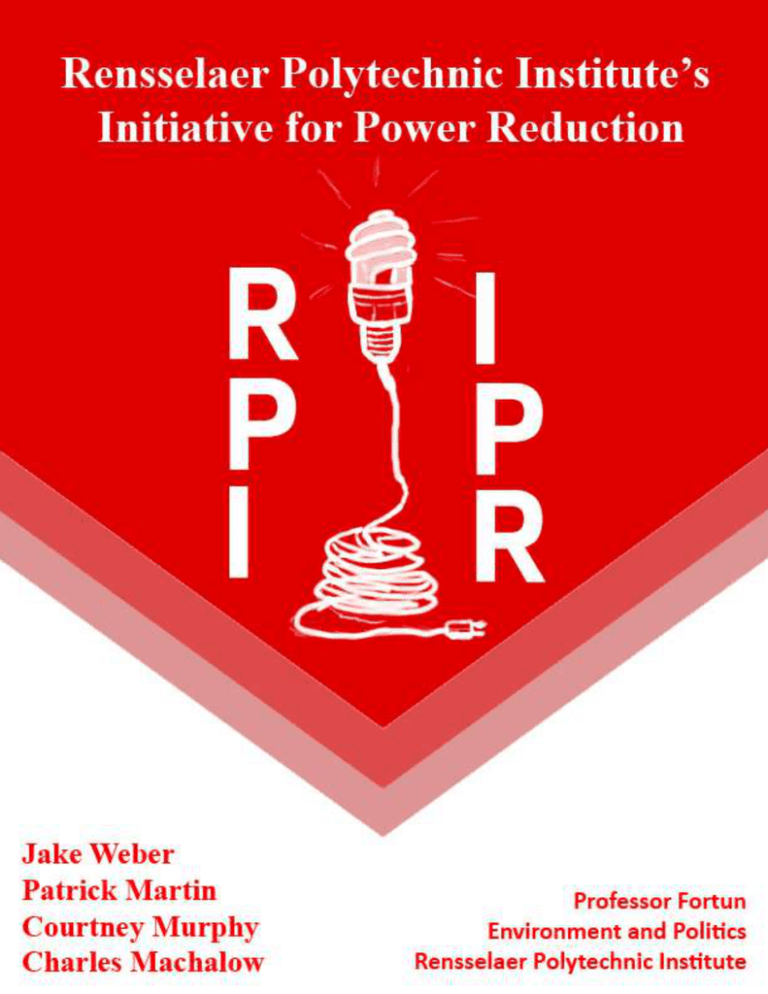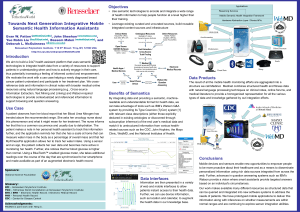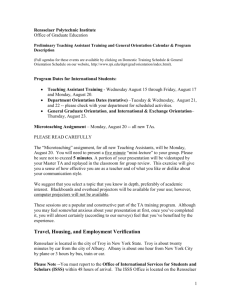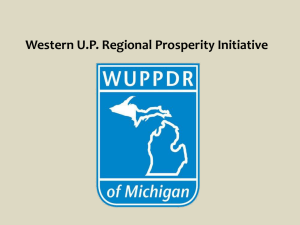RPI_s_IPR_final_Draft
advertisement

1 Rensselaer Polytechnic Institute’s Initiative for Power Reduction’s Mission Statement “Rensselaer Polytechnic Institute’s Initiative for Power Reduction, or RPI’s IPR, is a modern energy conservation program that seeks to revitalize the way energy is used on campus. The IPR backed by faculty and students will change the way all of the Rensselaer Community think about and use energy; creating a greater sense of community through saving energy. At the same time, the IPR will upgrade technology campus wide, modernizing its lighting, heating and cooling, and educating students to be the most energy efficient as possible.” Opening Sam is enjoying his first year at Rensselaer. As a Computer Science major, he has a plethora of electronic devices. Like many freshman, he lives in an on campus residence hall. He has class at 8:30 every morning, and every day he rushes out the door to get there. The last thing on his mind is his energy usage. Sam, the average RPI student, likes to spend his leisure time playing video games with his hall mates. Naturally, his Xbox and television are always plugged in. All day they needlessly sap energy from the rest of the campus. His lamp, iPhone charger, laptop, printer, hair dryer, razor, and speakers are no exception. They too waste power. He may remember to turn off the lights, but little does Sam know that the biggest waste of energy is the power strip he leaves plugged in all day. How would Sam know? Vampire power, like the mythological creature from which it gets its name, is a silent predator. One little light on each of his electronics is the only warning he has. All day, though these devices are not being used, electricity is. According to DoSomething.org, over the course of one year a TV can waste over 1400 kilowatt hours of electricity, up to $150. Game systems like the Xbox can waste up to 230 kilowatt hours, around 2 $25, while laptop chargers can waste around $15 per year. Each year, if about 5000 of RPI’s 5500 students like Sam did the same thing, around $950,000 would be wasted in unused electricity costs alone. What if there was someone who could inform Sam of proper energy use? What if there were programs at Rensselaer Polytechnic Institute that offered Sam the chance to learn about building a sustainable world? Rensselaer Polytechnic Institute’s Initiative for Power Reduction, or RPI’s IPR, is our proposal to give a student like Sam this enlightening opportunity. With our program Sam would have a live-in Energy Advisor, or EA, to assist him with questions or concerns he may have. He would have classes in buildings retrofitted with modern technologies, bringing comfort and conservation alike. If Sam forgot to turn off the lights after a night of hard work in the study room the new lighting system would kick in to automatically shut them off. And remember those vampires? Just one energy meter could show Sam how much electricity he’s wasting, letting him curb his bad habit. RPI’s IPR is the solution to a campus wide energy problem. We are a campus full of engineers, architects, and business majors who should be empowered to make the change they want to see in the world. These people are the future of energy conservation in our world, a future that is being built at RPI. It seems hypocritical for this future to be built in such a wasteful environment. If they are to succeed on a global stage, they must succeed at home first. If we are to change the world, we must first change the very campus we live on. Aims, Location, Site Justification and Organization The Initiative for Power Reduction is an energy conservation program centered on the campus of Rensselaer Polytechnic Institute. The IPR aims to achieve a large scale reduction in 3 the usage and thus the cost of electricity for every building and person of Rensselaer Polytechnic Institute. Starting with the very way our school thinks, the IPR will completely overhaul RPI’s way of life. First, a new advisor task, the “Energy Advisor”, or EA, will be an assignment added on to those of the Residential Advisors. The task of the EA is to examine each resident’s room, and to find and address any energy problems they encounter. The IPR believes the EA should be someone who can develop a close relationship with residents and help them learn better ways of thinking about their energy usage to ultimately make the residents more energy efficient. RPI’s IPR will also implement change by creating an additional short lecture to each Freshman Orientation session concerning energy efficiency. This lecture will include solutions each student can make to reduce his or her energy usage, and explain the purpose of the Energy Advisors. Each group of residents will have regular meetings with their EA, much like the regular meetings residents already have with their RA’s. Overall the IPR is striving to make sure that each student is always considering his or her impact on electrical resources and the needs of the school, and to make sure each sees him/herself and their usage as part of a whole. Furthermore, the IPR is going to update outdated technology in older buildings. This includes upgrading the lighting to make it as energy efficient as possible, adding additional motion-triggered lighting to make sure electricity is not being used unnecessarily, and supplementing existing insulation to save energy on heating and cooling. Certain buildings where these motion detectors can make a big difference are the residence halls, where sometimes the lights are left on all the time. Motion detectors would be a simple installation, and could end up saving RPI a large amount of money in the long run. The perfect place to start the Initiative for Power Reduction is RPI. Rensselaer is a leading technological institution, and therefore a great example for other universities to follow. 4 The IPR will create an exemplary solution to save energy costs at RPI, and hopes to share its ideas with other universities around the nation. Potential for Scaling Up and Out Among several possibilities for scaling out the IPR to other institutions is the ability to spread the idea of efficiency into areas other than RPI. After all, once a resident understands the waste associated with his or her electronic devices, he or she gains an incredible desire to use less. This desire could easily be carried onward via the trickle down effect. For instance, after graduating RPI, Sam is now the CEO of a computer manufacturing company, and he insists on only using assembly equipment that is of the utmost efficiency. Without his leadership, the company would have had dramatically higher energy usage, and therefore energy costs. Even if the cost itself wasn’t a problem, the carbon dioxide, dispersed by the likely coal-fired power plant, would be tremendous. After the carbon dioxide from energy production is accounted for, one still must take into account the lower emissions from the efficient equipment in general. RPI’s Initiative for Power Reduction had a powerful impact on Sam, which fundamentally shrunk his company’s carbon footprint on the world. Another way the IPR will spread out will be by word-of-mouth. Once other colleges see the success the IPR has had in lowering emissions and raising the level of sustainability on campus, they will yearn to do the same for their own school. This school will then become another example for others to follow, and the process will continue. The IPR will expand to other colleges, and soon after, its goals and solutions will be forever ingrained in the minds of the graduates. They will pass the information to more people and students, and an ever increasing number of people will strive to decrease their energy usage and carbon footprint. 5 The IPR can over time be scaled upward to become increasingly encompassing. This can happen as a result of a new grant issued every year of over $27,000 comes from an extremely minor increase in tuition, a mere two dollars a semester per student. With this money, the IPR will be able to further its goal of increasing energy efficiency on campus by implementing more up-to-date technology designed with sustainability in mind. The surplus from this yearly grant could be saved year after year to eventually fund incredibly large scale sustainability projects, such as modernizing older buildings. For example, each room in the Russell Sage Laboratory could have variable heating, so students and professors would not need to leave windows open during the winter. With time, RPI’s IPR will develop into a substantially integral part of the institute, raising the efficiency of the school while decreasing its carbon footprint. Related Project and Involved Organizations A campus newspaper article, entitled “Solid State Lighting Reduces Energy Consumption” by Michelle Simkulet, addresses one of the sustainability projects already underway at Rensselaer Polytechnic Institute. The project, run by the Smart Lighting Engineering Research Center Sustainability Club (SLERCSC), intended to increase the efficiency of the Darrin Communications Center’s second floor lighting by implementing new LED bulbs. The group is in full support of the installment and research of new sustainable technologies at RPI. It argues that the investment will eventually pay for itself. The group believed that the main way to accomplish this was to replace the three hundred 75 watt PAR30 halogen light bulbs, which are very outdated, with 15 watt LED light bulbs. These bulbs would be “...giving equivalent or better light quality with significantly longer lifetimes (estimated at 6 years compared to less than 6 months for the inefficient incandescent bulbs)” (Simkulet 2012). 6 The bulbs in the Darrin Communications Center run every day for all hours of the day. The initial energy savings are expected to be upwards of eighty percent. This makes the return on investment only eighteen months. The bulbs also last longer than the old halogen bulbs. “LED lighting (or solid state lighting, because semiconductor devices are generating the light) can now produce high quality light for almost any application, offering large reductions in electrical energy consumption and lifetimes 10 to 20 times longer than conventional bulbs and tubes” (Simkulet 2012). This means that the efficiency will continue for decades from one simple change. The price to get the bulbs is still an issue, but the group is working on a solution. You don’t see them too much on campus because this sustainable, energy saving technology is new and still expensive—but the newly formed Smart Lighting Engineering Research Center Sustainability Club…aims to make LED lighting on campus a key part of Rensselaer’s electrical energy reduction efforts. This is important because lighting is responsible for 20-40 percent of the total electrical energy used on campus (Simkulet 2012). Since twenty to forty percent of the electricity used on campus is allotted towards lighting, it is drastically important to maximize its efficiency. This is where RPI’s IPR can help. We will implement the LED technology in combination with motion sensors that will be placed in hallways, bathrooms and study rooms around campus. Resources in residence halls can be optimized as well. During the past five years, Oklahoma State University at Oklahoma City campus has saved one million dollars through its modernized energy conservation program. The entire Oklahoma State University program has saved twenty million dollars during the same time period. The main purpose of their energy conservation program is to save the Oklahoma State University system energy and money over 7 time through initial investments in greater energy efficiency. According to Patricia Ragle, OSUOKC Emergency Management Director, “OSU-OKC has been able to preserve precious financial resources and reduce pollution in our environment…What we’ve learned over the past five years will be leveraged for an even larger impact in the upcoming years” (“OSU-OKC”). Examples of efficiency changes Oklahoma State University has implemented through its program include: ▪ installation of energy efficient lights ▪ energy conservation devices on soda and snack vending machines ▪ improved monitoring and handling of air flow and quality ▪ sealed air leaks around windows and doors ▪ installed timers on drinking fountains for nighttime energy savings Furthermore, in early 2012, Oklahoma Governor Mary Fallin signed a bill into law that “…directs all state agencies and higher education institutions to achieve at least 20 percent improvement in energy efficiency and conservation by the year 2020” (“OSU-OKC”). The twenty million dollars saved by OSU through its energy conservation program represent a 19 percent improvement on such a scale. This information provides very positive reassurance for our hopes for the Initiative for Power Reduction’s success. Although we may not equal the twenty million dollars saved at OSU, there is no doubt that an energy conservation program on any scale would save a substantial amount of money for Rensselaer Polytechnic Institute. Many of the changes the Oklahoma State University made through its energy conservation program have already been proposed in our original ideas for the Initiative for Power Reduction. In addition, other changes made in the OSU energy conservation program, such as electricity saving 8 devices on soda and snack machines, improved monitoring and handling of air quality, and timers on water fountains for nighttime electricity savings, are potential additions to our program. However, the IPR is not just an effort to install new technology. We also strive to install a new mindset into the populous of RPI. OSU-OKC neglected this approach, and thus we believe our program’s potential far surpasses it in this regard. This demonstrates our firm belief that savings could be even higher at RPI through the IPR. SLERCSC and the campus efficiency program at OSU-OKC are not the only programs similar to the IPR. In fact, several similar programs exist on campus already. One of the most prominent is Engineers for a Sustainable World. The club not only helps the RPI campus through its biodigester project, but it helps other countries as well. The group has brought solar panels to Mexico and also revamped a used storage container into an orphanage for children in Haiti. Like the IPR, the group also focuses on education. By educating local elementary and middle school students on sustainability, ESW is bringing an environmentally aware generation into Troy, New York. EcoLogic and STS are also clubs on campus who put the environment as their main focus. RPI’s Initiative for Power Reduction can intertwine perfectly with these organizations. From fundraising, to education, to research, the sustainability clubs on campus and the Initiative can change Rensselaer into a better, more ecofriendly campus. Rationale The Initiative for Power Reduction is a priority for RPI for one simple reason, potential. The IPR has an impact on every level, both short and long term, direct and indirect. In the short term, RPI will see a substantial decrease in power usage, as the IPR overhauls multiple parts of the campus to be more efficient. 9 Shown here is a pie chart representing the total utility use per building at RPI from June 2011 to July 2012, courtesy of the Center for Future Energy Systems at RPI. During fiscal year 2012, RPI spent over $8 million in total utility costs for all the buildings. While this has decreased by $3 million since 2009, we still see room for vast improvement. Other utility usage figures include: Over 100 million gallons of water for all buildings with a cost of $700,000 Over 300 million Btu of heat energy, with a cost of $3 million About 70,000 kilowatt hours of electricity, with a cost of about $5,000,000 The most expensive building on campus was the Low Center for Industrial Innovation, using 9 million kilowatt hours during the year, with a cost of $650,000. This accounts for 10.8 percent 10 of the total utility usage at RPI. The IPR will significantly reduce the amount of electricity used, even at just the Low Center for Industrial Innovation, where much of the lighting is left on all day and all night. All should consider the IPR a priority as studies show that about 56% of energy produced in the United States is not actually used in the way one might think. This 56% is lost to vampire energy; that is energy lost when an electronic device is left plugged in. Contrary to popular belief, it is still using (or in this case, wasting) electricity. If IPR stopped this from happening just here at RPI, it would set a positive example for all other colleges. Over time, this will save hundreds of thousands of dollars, as seen in several similar programs across the nation. RPI could put such savings towards decreasing tuition costs, or furthering its endeavors into a more efficient campus. In effect, we would save RPI money, and RPI would save the students’ money. However, the long term impacts of our program are much greater. Students would graduate RPI well versed in the language of sustainability. It is our hope that each and every students’ brief term at RPI would not only be spent improving the campus, but also improving their future careers. Students would graduate with efficiency in mind, and we believe will apply it to the rest of their lives. Project Design and Context The Initiative for Power Reduction will be a campus-wide effort run through the School of Engineering at RPI. To achieve our goal of education and efficiency alike, the IPR will be split into three main components: Sustainable Energy Advising, Sustainable Energy Lectures, and Sustainable Buildings Technology. The first component to be implemented will be Sustainable Energy Advising, which will begin during the Residential Advisor training seminars. In addition to the training they already 11 receive, Residential Advisors will also be trained for the new “Energy Advisor” assignment. This additional task of an RA will be to ensure that their residents are using electricity sustainably in their respective residence halls. They will do this by having new “energy checks” that will be performed at the same time as the current room checks. Each RA will go into their resident’s rooms and examine how their residents are using electricity. Key aspects an RA might be noting include: the number of power strips and the number of devices plugged in, the number of various chargers, if power strips are turned off while not in use, if the chargers are left plugged in and not charging, and more. Next, the RAs will take the skills and knowledge they learned during their training and apply them to the situation. If their residents are not using electricity as sustainably as they could, the RA will be able to create a quick and easy solution, like making sure their residents shut off power strips before they leave their rooms for class each day. Each month, the amount of electricity used in each residence hall will be reported to the Residence Director of the hall. Throughout the semester and year, the RD will (hopefully) see a reduction in the electricity use of the hall, and be able to report this to the RAs. The RAs will then report this to their residents during two mandatory energy meetings, one at the midpoint and one at the end of each semester. With these meetings, the residents will be able to see the results of their actions, and will be motivated to do more. During these meetings the RAs will relay and reiterate certain messages to their residents, making sure that they understand that saving electricity is not only good for the environment, but also good for each student financially. More saved money from saved energy will result in more money for RPI. This in turn will net more funding for academic programs, and even possibly a reduction in student tuition, both very positive effects for all. The next component of the IPR to be implemented will be Sustainable Energy Lectures. These lectures will begin at Freshmen Student Orientation, and will continue throughout each 12 student’s career at RPI. Student Orientation (SO) advisors, already responsible for several similar lectures, will be the presenters. The SO lecture will cover how students currently feel about energy efficiency and what they do currently do to be energy efficient. Being students themselves, SO advisors can also inform new students of their experience with the program. It will also inform them of the Initiative for Power Reduction and what they will be asked of during the year from RPI in terms of energy usage. The main idea for this SO lecture is to get all incoming RPI students interested in sustainable energy efficiency right from the start of their time at RPI. Next, there will be additional lectures during each semester; one mandatory lecture per semester, along with optional lectures for those students interested in the IPR. Each class (freshman, sophomore, junior, and senior) will have its own separate lecture, making sure that each student attends. Professors from the School of Humanities, Arts and the Social Sciences, specifically those from Sustainability Studies classes, will speak at the lectures, stressing the importance of sustainable energy efficiency. The specific material to be covered in each lecture will be determined by the lecture Professors in conjunction with the leaders of the IPR in the School of Engineering. Overall, these lectures are meant to reinforce the message of the IPR to every student at RPI at least once per semester. The more the message is stressed, the more effective the IPR will be. The third and final component of the IPR is Sustainable Buildings Technology. This component includes upgrading technology and retrofitting buildings at RPI to make them as energy efficient as possible. Chart A-1, which briefly explains the Sustainable Buildings Technology component, is attached to the end of this report. This chart begins with building evaluations. To fully evaluate the ways in which energy is being wasted and how it can be saved, professors from the School of Engineering (electrical engineering, electronics, lighting research, 13 etc) and sustainable lighting professionals from industry will come together to reach our goal. We are hoping to utilize the assistance of industry professionals such as those from GE Lighting Solutions to help evaluate each building. The professors and professionals will do a full campus sweep, building by building, and look through information on utility usage per building on campus. They will determine when the building is wasting energy, and when peak hours of student or professor activity are. Depending on when the building is wasting energy, different solutions will be created. For example, if lighting is the main source of wasted electricity during the day (which we expect), solutions such as replacement LEDs, more motion detectors, and LEDs that dim according to the level of natural light in the room can be implemented. The night solutions will be the same for lighting, with additional solutions for other sources of wasted electricity. For example, if many printers are left on all day and all night, we can set the printers to shut off after a certain time in the evening. In addition, many buildings leave soda machines and water fountains on all night long, at times when no person is going to use them. Setting timers on these will save electricity over time, thus saving RPI money over time. Furthermore, we are expecting the building evaluators to find certain sources of wasted electricity that we have not considered yet, therefore creating more viable solutions. Another way to increase the energy efficiency of the buildings on campus is to improve their insulation. We cannot yet estimate the cost at this point because we are awaiting building insulation evaluations from specialists. Our hope is that by properly insulating these buildings, energy efficiency can increase as less heat will be lost to the environment. In 2011, the College Sustainability Survey gave RPI a low grade in the green buildings section. With new policies set by the IPR, the new buildings on campus must be built to be LEED Silver certified. In 2011 there was only one LEED certified building and one LEED Gold certified building. By changing the 14 insulation we would be able to have more buildings certified. This simple change can save energy and money, and will bring the standings of RPI sustainability up. Involving the stakeholders in this project is quite simple. To involve the students we have introduced the Energy Advisor position as well as sustainability lectures. There will be one per semester that students will be required to attend. The lectures throughout the semester will not be mandatory, but will be strongly encouraged. Professors will be involved primarily through the lighting changes in their classes. They can further be involved though giving lectures and mentoring students through their sustainability research. Administrators will be encouraged to make policies and donations that would positively affect our project. This could be through a requirement for all classroom lights to be shut off if they are not being used. Administrators would also be involved in spreading the IPR to other universities through seminars and conferences. Electrical workers would directly handle the lighting systems along with other new 15 technologies (ex: timers, heating, etc.) and would be responsible for correctly installing such systems. Electrical companies would be affected by the decrease in energy needed by RPI. Finally, Residential Advisors would be involved via the additional tasks involved with being an Energy Advisor. They would be trained and required to educate their residents on energy efficiency. The stakeholders are the key to the projects’ success. Certain trends will unmistakably affect Rensselaer’s Initiative for Power Reduction. A current social trend that will affect the project in a positive way is the slowly growing yen for green energy. Surely if people want energy that is produced in a cleaner, and more sustainable manner, they will also want to use energy in a more efficient way. This social trend also propagates into a political trend with many politicians pushing bipartisan measures to lower our dependence on foreign energy and invest in homegrown renewable energy. Furthermore, a very prominent economic trend is that people want to save money, and with the ever increasing cost of tuition, our initiative has the potential to lower the institute’s yearly utility costs. We believe that this decrease in cost will lead to a lowering of the cost of tuition by a noticeable margin. Together all these trends work to push the project forward faster and farther than ever before possible. We will evaluate the success of the project by the amount of energy saved. The amount of energy consumed on campus will be measured before the Initiative is underway. The same measurement will be taken each year and a complete evaluation of the project will be taken at the end of the sixth year. This time period of six years will allow us to follow students from freshman year through two years after graduation. It also allows time for the building restorations to occur. In the past eleven years, RPI has seen a decrease in energy usage by six percent. The aim of RPI’s IPR is to decrease our energy usage by another ten percent in six 16 years. We believe this is feasible goal as we are not only changing technology, we are changing behavior as well, which can be carried out during a lifetime. There are some significant barriers in front of the success of Rensselaer Polytechnic Institute's Initiative for Power Reduction. One obstruction is in the form of resistance to change that most people exhibit. People will (at first) be unwilling to change their habits when it comes to unplugging electronics and turning lights off, and yet when the RPI motto asked: “Why not change the world?” and the average person’s rebuttal is “because it’s fine as is.” It’s clear to a Rensselaer graduate however, that the world is not perfect and we should do everything in our power to make it better. Clearly it is difficult to teach first year students the RPI mindset: that they can do something great, no matter the size or extent of their project. However as the proposers of the IPR, we firmly believe that with time, all RPI students will gain an appreciation for “Why not change the world?” and soon they’ll ask themselves that very question. RPI’s IPR gives students a multitude of ways to make the world more efficient and sustainable; so that when a group of the student populous illustrates the IPR’s morals, together we undoubtedly change the world for the better, overcoming this first obstacle. A second impediment to the IPR invokes the question of obtaining funding. However, according to the College Sustainability Report Card, Rensselaer received an “A” for investment priorities. “The institute aims to optimize investment returns, and the endowment is currently invested in on-campus efficiency projects and renewable energy funds. The institute also uses investment managers who consider environmental and sustainability factors. Donors can request that gifts be directed into sustainable and socially responsible investment options” (“Report Card 2011”). Undoubtedly, once RPI’s IPR is an option for “green minded” donors, there will be an incredible sum of funds being donated to our cause on a recurring basis. Concurrently, there are a multitude of grants that 17 can be applied for. The EPA recently awarded RPI’s Engineers for a Sustainable World chapter with a $15,000 grant for its sustainable activities. The school of engineering also awarded the club with $3,500. Funding for our cause exists, and is widely available. Although there will be some initial barriers in the way of the IPR’s success, they will be remedied quickly, heeding way to an incredibly effective program. Closing Sam, who greatly benefited from the sustainability awareness he gained at Rensselaer Polytechnic Institute, now looks for interns who share his concerns. One of the interns he hired, Kelly, graduated from RPI fifteen years after Sam did. When Sam was a student, RPI’s IPR was just beginning. Now, with Kelly, he can see the impact. Kelly has already brought new sustainable technologies to Sam’s attention that he never knew of. Through the IPR lectures she attended she was able to describe the technologies in a way that made sense to all of her fellow interns. With these technologies, Sam plans to renovate his offices, making the architecture, heating, and lighting systems more efficient. With these efficiencies, Sam’s company looks more modern, innovative, and attractive than his competitors. He is also able to put the money that he saves from his energy bill into expanding his company. The expansion of RPI’s IPR had a noticeable impact on Sam and Kelly. Rensselaer Polytechnic Institute's Initiative for Power Reduction has the ability to grow. It starts small, with changing a few light bulbs. Once students learn from their Energy Advisors, the sustainability message expands. Students become aware of the changes made on campus. The amount of money saved begins to rise and the students eventually see a decrease in their tuition bill. The students graduate. They bring the RPI’s IPR message with them to their graduate 18 schools and employers. Other universities and corporations catch on, and soon the IPR message has spread much further than the campus bounds. We have the power to be sustainable and the ability to change the world. Change RPI...Change the World. Works Cited “OSU-OKC Saves $1 Million Through Energy Conservation Efforts." Oklahoma State University Energy Conservation Program. Oklahoma State University, 17 Aug. 2012. Web. 29 Oct. 2012. <http://www.okstate.edu/energy/>. "Report Card 2011- Rensselaer Polytechnic Institute College Sustainability Report Card 2011." The College Sustainability Report Card. Sustainable Endowments Institute, 2011. Web. 29 Oct. 2012. http://www.greenreportcard.org/report-card-2011/schools/rensselaerpolytechnic-institute>. Simkulet, Michelle. "Solid State Lighting Reduces Energy Consumption." The Rensselaer Polytechnic. Rensselaer Polytechnic Institute, 12 Sept. 2012. Web. 28 Oct. 2012. <http://poly.rpi.edu/2012/09/12/solid_state_lighting_reduces_energy_consumption/>. 19 Evaluations for Sustainable Building Technology Professors (Electrical engineering, electronics, lighting research) and sustainable lighting professionals (GE) will come in during the day and night during the first semester of the program They will determine: When is the building wasting electricity? When are the peak hours of student/professor activity? Nighttime – Peak during day Daytime – Peak during day Why is electricity being wasted? Lighting Motion detectors Why is electricity being wasted? Replacement LEDs LEDs that dim according to level of natural light Lighting Other Solutions Solutions Replacement LEDs Motion Detectors Timers on printers Timers on soda machines and water fountains “Smart” power strips to power off entire classrooms for the night Chart A-1 20






